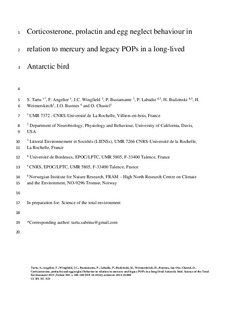| dc.contributor.author | Tartu, S. | |
| dc.contributor.author | Angelier, F. | |
| dc.contributor.author | Wingfield, J.C. | |
| dc.contributor.author | Bustamante, P. | |
| dc.contributor.author | Labadie, P. | |
| dc.contributor.author | Budzinski, H. | |
| dc.contributor.author | Weimerskirch, H. | |
| dc.contributor.author | Bustnes, Jan Ove | |
| dc.contributor.author | Chastel, O. | |
| dc.date.accessioned | 2018-01-23T17:53:07Z | |
| dc.date.available | 2018-01-23T17:53:07Z | |
| dc.date.created | 2015-01-08T12:05:30Z | |
| dc.date.issued | 2015 | |
| dc.identifier.citation | Science of the Total Environment. 2015, 505 180-188. | nb_NO |
| dc.identifier.issn | 0048-9697 | |
| dc.identifier.uri | http://hdl.handle.net/11250/2479206 | |
| dc.description.abstract | Seabirds often have high loads of contaminants. These contaminants have endocrine disrupting properties but their relationships with some endocrine mechanisms are still poorly investigated in free-living organisms. This is the case for the stress response which shifts energy investment away from reproduction and redirects it towards survival. In birds, this stress response is achieved through a release of corticosterone and is also accompanied by a decrease in circulating prolactin, an anterior pituitary hormone widely involved in regulating parental cares.We measured blood concentrations of some legacy persistent organic pollutants (POPs) andmercury (Hg) and examined their relationshipswith the corticosterone and prolactin responses of known-age (9–46 years old) incubating snow petrels (Pagodroma nivea) to a standardized capture/handling stress protocol. In this Antarctic seabird, we also investigated whether high contaminant burden correlates with a higher occurrence of egg neglect, a frequently observed behavior in snow petrels. POPs and Hg were unrelated to age. Stress-induced corticosterone concentrationswere positively related to POPs in both sexes, and stress-induced prolactin concentrations were negatively related to Hg inmales. Egg-neglect behavior was not related to POPs burden, butmales with higher Hg concentrations were more likely to neglect their egg. This suggests that in birds, relationships between age and contaminants are complex and that even low to moderate concentrations of POPs and Hg are significantly related to hormonal secretion. In this Antarctic species, exposure to legacy POPs and Hg could make individuals more susceptible to environmental stressors such as ongoing disturbances in Polar Regions. | nb_NO |
| dc.language.iso | eng | nb_NO |
| dc.rights | Attribution-NonCommercial-NoDerivatives 4.0 Internasjonal | * |
| dc.rights.uri | http://creativecommons.org/licenses/by-nc-nd/4.0/deed.no | * |
| dc.title | Corticosterone, prolactin and egg neglect behavior in relation to mercury and legacy POPs in a long-lived Antarctic bird | nb_NO |
| dc.type | Journal article | nb_NO |
| dc.type | Peer reviewed | nb_NO |
| dc.description.version | acceptedVersion | nb_NO |
| dc.source.pagenumber | 180-188 | nb_NO |
| dc.source.volume | 505 | nb_NO |
| dc.source.journal | Science of the Total Environment | nb_NO |
| dc.identifier.doi | 10.1016/j.scitotenv.2014.10.008 | |
| dc.identifier.cristin | 1193044 | |
| dc.relation.project | EU/Marie-Curie Fellowship, no. 237034 | nb_NO |
| dc.relation.project | Norges forskningsråd: 234423 | nb_NO |
| cristin.unitcode | 7511,4,0,0 | |
| cristin.unitname | Tromsø | |
| cristin.ispublished | true | |
| cristin.fulltext | postprint | |
| cristin.qualitycode | 2 | |

